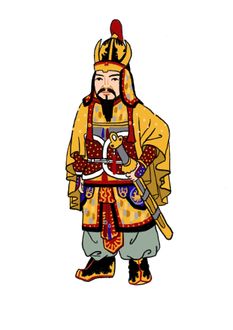"Expander and Opener of Goguryeo's Territory, King Gwanggaeto"의 두 판 사이의 차이
| 1번째 줄: | 1번째 줄: | ||
{{Kor Article| | {{Kor Article| | ||
| − | |Article= | + | |Article=광개토대왕: 드넓은 영토를 차지하다 |
}} | }} | ||
2017년 11월 29일 (수) 10:12 기준 최신판
King Gwanggaeto the Great (374–413, r. 391–413) was the 19th king of Goguryeo, one of the kingdoms of the Three Kingdoms period. Under his reign, Goguryeo reached its zenith, extending across all of Manchuria and uniting all but the lower one-third of the Korean peninsula. He died at the age of 39 and his posthumous title, Gwanggaeto, which means “expander and opener of territory,"[1] reflects the nature of his accomplishments.
During Gwanggaeto’s reign, Goguryeo used its own reign year, Yeongnak, demonstrating that Goguryeo was a formidable competitor of Chinese dynasties at the time. He is also one of two kings in Korean history, along with Sejong of Joseon, to receive the title “The Great.”
Gwanggaeto, whose given name was Dam-deok, was born in 374 as the son of King Gogugyang. He was designated heir to the throne in 386 when his father became king, and it is said that he aided his father on the battlefield when he was a teenager[2]. In 391, at the age of 18, he ascended the throne upon his father’s death.
Gwanggaeto began his reign in a period when Baekje was the strongest kingdom on the peninsula. However, he greatly expanded Goguryeo territory to both the north and south, making Goguryeo a powerful East Asian empire. To the north, he defeated Khitan tribes in the Liaotung region and nomadic tribes in Manchuria. To the south, he conquered the northern side of the Han River basin from Baekje and successfully defended against Japanese invaders aiding Baekje. These victories also led to the dissolution of the Gaya confederation, which had allied with Baekje. During his reign, he also incorporated the territories of Dongye and East Buyeo, while Buyeo and Silla became vassal states.
Gwanggaeto died in 413 of an unknown illness[3]. In honor of his accomplishments, his son and successor, Jangsu, erected a stele the following year at Gwanggaeto’s tomb site in the Goguryeo capital, Gungnaeseong (present-day Ji’an, China). This stele, called the Stele of King Gwanggaeto, is around 6.4 meters tall, 1.4-2 meters wide, and around 1.4 meters deep. Carved onto it are 1,802 characters which record the origin story of Goguryeo, the accomplishments of Gwanggaeto, and other information. The stele, rediscovered in the late 19th century, is one of the oldest extant resources about the Three Kingdoms period and is therefore a valuable historical resource.
Related Articles
- Relations between Korea and Japan in Ancient Times
- The Spirit that Conquered the Mainland - Goguryeo
- The Furnace of the Korean Peninsula - The Three Kingdoms Period
- King Gwanggaeto (Goguryeo)
- King Gogugyang (Goguryeo)
- King Jangsu (Goguryeo)
- Gungnaeseong
- Stele of King Gwanggaeto
